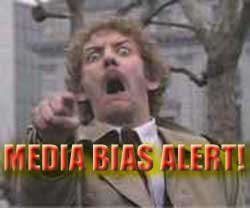 Earlier this week, NPR's David Folkenflik broke a story about New York Times reporter Linda Greenhouse's leftist political speech at Harvard Law School. In the comment thread from my original post, reader Charlie wrote:
Earlier this week, NPR's David Folkenflik broke a story about New York Times reporter Linda Greenhouse's leftist political speech at Harvard Law School. In the comment thread from my original post, reader Charlie wrote:
I'm sorry, but I would MUCH rather have a reporter who wears their biases openly than one who hides them -- or worse, one who has no opinions.
I agree that there is a great deal to be said for reporters being transparent in their views. But the issue isn't simply Greenhouse and her political views. The goal of objectivity in journalism refers to the methodology of the newsroom, not the empty minds of the various reporters and editors involved in getting stories to print.
Newspapers run into problems because even if they strive for objectivity, they suffer a stunning lack of diversity in their newsrooms when covering divisive issues. It's not news that reporters share similar views on a wide swath of social and economic issues. I have never been a Greenhouse fan, a sentiment which I'm certain causes her to cry over her many journalism awards. But any complaints I've had about her writing have been marginal or based in my fear that I can't trust her because of her activism.
But what if Greenhouse were part of a team that comprised a variety of viewpoints and knowledge bases? How would the coverage differ if a reporter who was morally conservative worked with her?
Well, near as I can tell, there's absolutely no danger of newsrooms seeking more diversity in which biases they bring into their newsroom. Very few could bring themselves to comment on the story. Even Daniel Okrent, the former ombudsman at the Times, clarified his earlier remark that he was amazed by her speech. In an interview with Newsweek, he said he was thrilled by her outspoken speech.
Do you think it's a farce to pretend that media bias doesn't exist? Obviously it exists in individuals, and it exists in institutions, but it does not exist in all individuals, and it does not exist in all institutions. It's like anything else in the world, there are those who do it right and those who do it wrong.
What does this mean for journalists who may not want to suppress their political views outside the office? Well, that's the thing about it that's so interesting and amazing and exciting. Maybe this opens up the conversation that journalists can and should [participate].
In my view, this is not about whether reporters can march in rallies or display bumper stickers or donate to candidates. To me, this is about the fact that if they did, there would be very few reporters marching in pro-life rallies.
A decade ago, the Los Angeles Times analyzed media coverage of abortion and found that bias infiltrated reports of the divisive issue. A few years ago, Times editor John Carroll wrote a memo to the staff telling them to work harder to get their abortion biases out of the newspaper.
That happens despite reporters' best intentions. Could the attempts to write fairly about abortion and other divisive issues be hampered by the stunning and shocking lack of intellectual diversity in America's newsrooms?
